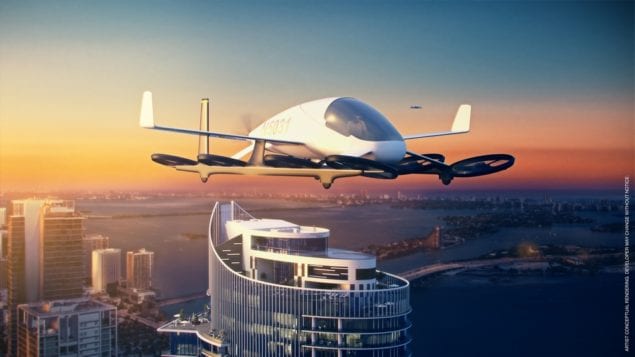Flying cars and ground transportation will coexist in the future, but their roles and dominance will depend on various factors. In recent years, the concept of flying cars, also known as vertical takeoff and landing (vtol) vehicles, has gained popularity.
It promises to revolutionize transportation by providing a faster and more efficient way of traveling. On the other hand, ground transportation, including cars, trains, and buses, is already an established and reliable means of transportation. The future of these modes of transportation will depend on various factors, such as technological advancements, infrastructure development, government regulations, and public perception.
This article will explore the current state and potential of flying cars and ground transportation, their advantages and limitations, and their potential impact on the future of transportation.

Credit: economictimes.indiatimes.com
The Pros And Cons Of Flying Cars
Flying cars, also known as vertical take-off and landing (vtol) vehicles, have long been a staple of science fiction and appear to be making their way into reality. With innovative technology, it’s possible flying cars could one day revolutionize transportation as we know it.
But before we get too excited, let’s consider both the pros and cons of flying cars and how they compare to traditional ground transportation.
Increased Efficiency And Time-Saving
One of the main advantages of flying cars is the ability to reach your destination much faster than through ground transportation. You could fly a straight line to where you need to go, without worrying about traffic, stoplights or any other type of interruption.
This would make travelling significantly easier and less time-consuming, but it might be limited to just long journeys.
However, there are concerns about flight regulations and airspace traffic, particularly in urban areas where routes could be restricted. In addition, getting a flying car license is a costly and time-intensive process, which could limit their feasibility for most consumers.
Reduced Traffic Congestion
Flying cars could also have a significant impact on reducing traffic congestion, especially if they can transport passengers directly to their destination without the need for a runway. With the growth of urbanization, flying cars could be used to take off and land from designated areas on top of buildings or in specially designed landing pads.
This could change the way we think about urban planning and open up new opportunities for transportation networks.
However, flying cars also pose a risk to traditional air traffic, which includes commercial airlines, helicopters, and small planes. Safety precautions and regulations would need to be implemented to ensure everyone stays safe in the air.
Environmental Concerns
With concerns about climate change and carbon emissions, it’s important to consider the environmental impact of flying cars. Although they may be more fuel-efficient than traditional cars, they still emit pollution, and this could make the air quality even worse, particularly in urban areas with poor air quality.
Safety Challenges
Safety is a top priority when it comes to transportation, and flying cars come with unique safety challenges. There are many factors to consider when it comes to flying cars, including air traffic, weather, and other potential hazards. Regulations and safety procedures must be implemented to ensure that these vehicles are safe for passengers and others in the air.
Noise Pollution
Flying cars could also be a significant source of noise pollution, especially in urban areas. The sound of flying cars taking off and landing could be disruptive, irritating, and potentially harm the quality of life. Further research and development should be conducted to minimize noise pollution.
While flying cars offer a potential solution to traffic congestion and faster transportation, they also come with several drawbacks, such as safety concerns, environmental impact, and significant challenges to infrastructure, flying regulations and costs. Ground transportation has its drawbacks too, but it has the advantage of being well-established and less disruptive to the status quo.
Ultimately, the question of which option is better depends on many factors, including how flying cars are regulated, how they integrate into an existing transportation system, and how cost-effective they are to operate.
Ground Transportation: The Undisputed King
Flying Cars Vs. Ground Transportation: Which Will Dominate The Future?
With the advent of technology, society has been dreaming of the day when they can fly in a car. While flying cars may seem like a fantastic invention that will revolutionize transportation, the ground transportation industry continues to prosper. In this blog post, we will take a closer look at why ground transportation is still the king of the road and what advancements are being made in the industry.
Current Trends In The Ground Transportation Industry
The ground transportation industry is ever-evolving, and with each passing year, new trends emerge. Some of the current trends in the ground transportation industry include:
- Increased demand for ride-sharing services
- Growth in the luxury transportation market
- Adoption of eco-friendly rides.
These trends have contributed significantly to the automotive industry’s prosperity, ensuring the ground transportation industry’s undisputed reign.
Advancements In Electric Cars
Electric cars offer a promising alternative to traditional gasoline-powered vehicles. They are eco-friendly and cost-effective in the long run. The advancements in technology have made electric cars more accessible to the general public. Some of the key advancements in electric cars include:
- Increased battery capacity for longer ranges
- Improved charging infrastructure
- Introduction of wireless charging
Adopting electric cars may not eliminate traditional vehicles, but it offers a sustainable option for ground transportation.
The Role Of Self-Driving Cars
Self-driving cars have been a dream for decades, and it’s finally becoming a reality. The technology behind self-driving cars is impressive, and it offers a lot of possibilities, including:
- Increased safety on the road
- Reduced traffic congestion
- Reduced parking space requirements
Advancements in self-driving cars are being made every year. As this technology becomes commercialized, it is expected to play a significant role in the ground transportation industry.
Public Transportation Vs. Personal Vehicles
The choice between public transportation and personal vehicles is often a personal preference. However, there are pros and cons to both options.
Public transportation offers a cheap and sustainable option, but it often lacks convenience and flexibility. Personal vehicles, on the other hand, offer flexibility and convenience, but they contribute to environmental pollution and require significant financial investment.
The ground transportation industry’s future remains bright, with advancements in technology and growing demand for eco-friendly rides. While flying cars may seem like an exciting prospect, ground transportation will remain the king of the road.
Implementation Of Flying Cars: The Challenges And Opportunities
Flying cars have been a fascinating topic for many science fiction enthusiasts for years. With advanced technology, this idea is slowly becoming a reality. The emergence of aerial transportation solutions raises the question, could flying cars be the primary mode of transportation in the future?
We will be exploring some significant considerations for the implementation of flying cars and their potential opportunities in contrast to ground transportation.
Infrastructure Needs
The infrastructure required for the implementation of flying cars is complex and challenging. It is a significant challenge to build vertical take-off and landing (vtol) infrastructure in highly populated areas. The following are some of the essential infrastructure needs to implement flying cars.
- Adequate space and height clearance for flying cars
- A network of charging and maintenance stations for electric flying cars
- Setting up air traffic control systems to control the movement of flying cars
Regulatory And Legal Issues
Regulatory and legal issues are one of the significant challenges for the implementation of flying cars. Regulations need to be implemented to ensure safe flight operations and protect civilians on the ground. The following are some of the regulatory and legal challenges that need to be addressed before implementing flying cars.
- Developing air traffic management standards for flying cars
- Setting up, testing, and maintaining cybersecurity systems for digital systems at all levels of the vtol network
- Developing and implementing pilot licensing, airworthiness, and operator requirements for flying cars
Affordability
The affordability of flying cars may be a significant challenge. Currently, such vehicles are expensive to develop, produce and maintain. Additionally, flying cars require innovative technology, which is still in the research and development stages. The following are some of the affordability challenges of flying cars.
- High initial cost for producing flying cars
- Costly maintenance and repairs due to a lack of readily available qualified technicians
- High insurance rates due to the risks associated with aerial transportation
Accessibility
Accessibility of flying cars is another significant challenge. These vehicles require highly trained and skilled pilots to operate; therefore, it may not be accessible to the general population. Moreover, not every location would be appropriate for flying cars, and this requirement may result in accessibility issues.
The following are some of the challenges for accessibility of flying cars.
- The driving force behind the development of flying cars is only to satisfy the luxury or niche markets.
- Flying cars may only be available to people living in areas where the necessary infrastructure is already in place, such as high-tech cities in developed countries.
Opportunities For Business And Innovation
The development of flying cars has enormous potential for entrepreneurs and innovators to create exciting new products and services. The following are some of the opportunities for businesses and innovation in the industry.
- The development and implementation of innovative charging and maintenance stations network for flying cars
- New service models, such as air ride-sharing alternatives
- New job opportunities for pilots, engineers and technicians in the aviation industry.
The implementation of flying cars has many challenges that need to be addressed before they can become a primary mode of transport. Despite these challenges, the emergence of this technology creates many opportunities for businesses and entrepreneurs to develop innovative solutions to facilitate this new mode of transportation.
Frequently Asked Questions Of Flying Cars Vs. Ground Transportation: Which Will Dominate The Future?
Will Flying Cars Replace Ground Transportation In The Future?
It’s unlikely that flying cars will entirely replace ground transportation. Both modes of transport have their advantages and disadvantages. Flying cars could be more efficient for long distances, but ground transportation is still necessary for short trips, deliveries, and local transportation.
What Are The Potential Benefits Of Flying Cars Over Ground Transportation?
Flying cars have the potential to reduce congestion on roads, improve travel times for longer distances, and offer faster emergency services. They could also increase accessibility to remote areas and provide additional travel options.
What Are The Potential Drawbacks Of Relying On Flying Cars?
Flying cars would require new infrastructure, regulations, and air traffic control solutions. They would also likely be more expensive to produce and maintain than conventional vehicles. Additionally, there would be safety concerns, as flying vehicles pose a greater risk should something go wrong in the air.
Conclusion
As technology continues to advance and society progresses, the debate between flying cars and ground transportation as the future of transportation remains a hot topic. Both options have their advantages and disadvantages with regards to economic, environmental, and practical considerations.
While flying cars may offer the allure of faster and more efficient travel, they also bring about concerns such as safety, infrastructure, and noise pollution. On the other hand, ground transportation may be seen as a more practical option due to its existing infrastructure and lower cost.
However, it also faces challenges such as traffic congestion and limited travel speed. Ultimately, the future of transportation could potentially see a combination of both, with advancements in technology and further consideration of environmental and societal impacts. Regardless of what the future of transportation may hold, the ultimate goal should be to balance innovation with practicality and sustainability to create a better and more efficient society.

